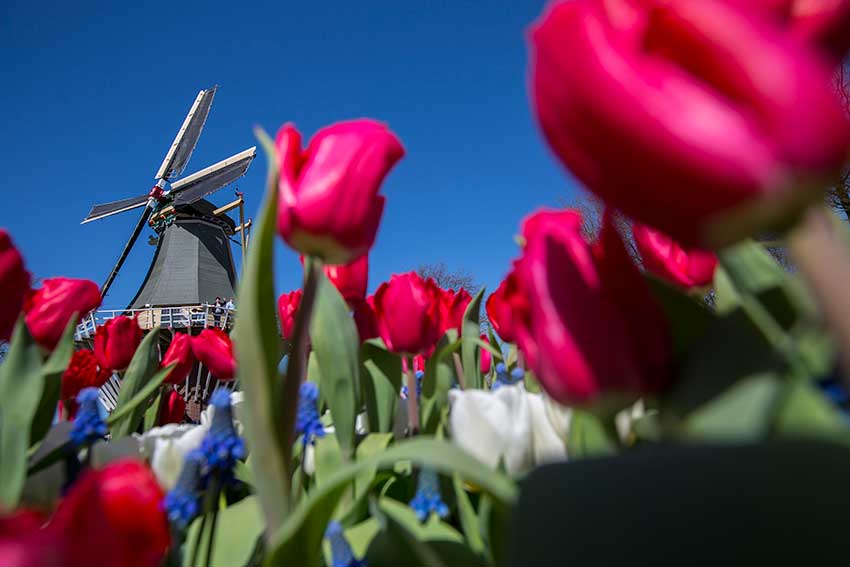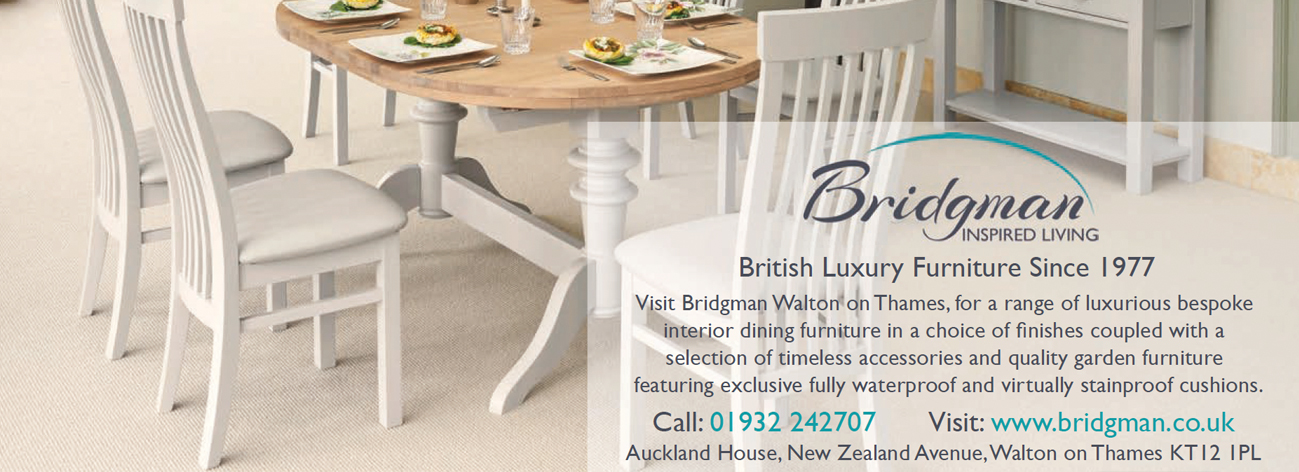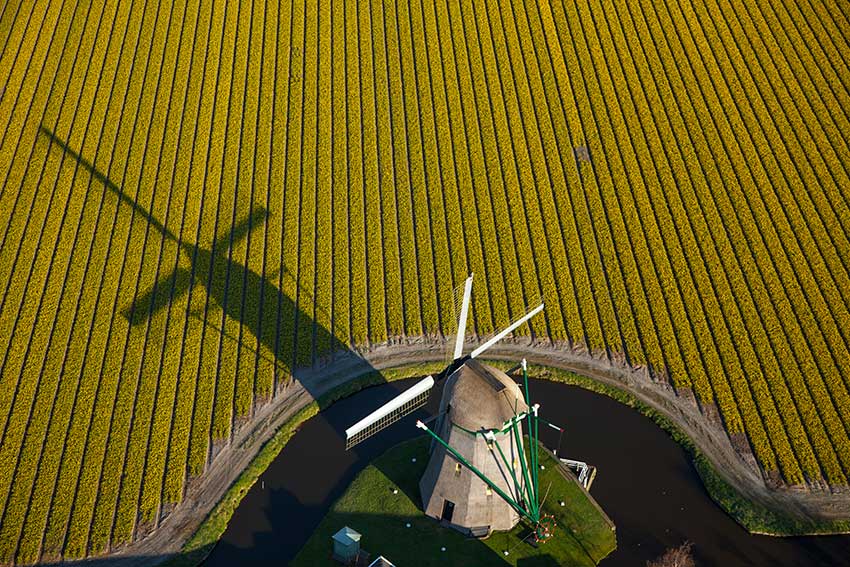TRAVEL
Surrey’s Premier Lifestyle Magazine
Tulips in Amsterdam
Spring is the ideal time of year to visit Amsterdam and the tulip flower gardens, as Kevin Pilley discovered.
We agreed on one thing. It would be a Tiny Tim Free Zone. Instead we tip-toed through the tourists through The Greatest Flower Show On Earth.
The 32-hectare Keukenhof (kitchen) garden in Lisse, between Amsterdam and Haarlem, is one of the world’s largest flower gardens and perhaps its most famous spring garden. Seven million bulbs are planted every year, flowering from the end of March to the end of May. The best time to see tulips – the unofficial flower of the Netherlands – is mid-April to May.
Situated in fifteenth century hunting grounds, Keukenhof, a forty-minute bus ride from the capital, was originally the source of herbs for the local castle. The garden was established in 1949. Surrounded by commercial bulbfields, it’s a showroom for the queen of bulbs and a peaceful place. Which means you aren’t continually dodging cyclists or trams. Only selfie sticks.
The 32-hectare Keukenhof (kitchen) garden in Lisse, between Amsterdam and Haarlem, is one of the world’s largest flower gardens and perhaps its most famous spring garden. Seven million bulbs are planted every year, flowering from the end of March to the end of May. The best time to see tulips – the unofficial flower of the Netherlands – is mid-April to May.
Situated in fifteenth century hunting grounds, Keukenhof, a forty-minute bus ride from the capital, was originally the source of herbs for the local castle. The garden was established in 1949. Surrounded by commercial bulbfields, it’s a showroom for the queen of bulbs and a peaceful place. Which means you aren’t continually dodging cyclists or trams. Only selfie sticks.

Photo copyright: Cris Toala Olivares-Rechtenvrij | iamamsterdam
There are 800 varieties of tulip on show and probably more nationalities than cultivators. It is a bulb zoo. As well as daffodils and hyacinths, you walk through beds of single earlies like Princess Irene, double earlies like Monte Carlo, Darwin Hybrids, single lates, lily-flowered tulips such as Ballade and Ballerina, fringed Blue Herons, Red Hats, green viridflora, flamed or broken tulips like Zomerschoon, twisted parrots, bi-coloureds and low-growing striped Greigii like Red Riding Hood and Pinocchio.
You must visit the city’s Tulip Museum for a preliminary history lesson. Says curator Sjoerd van Eeden: “The tulip is native to the northern foothills of the Himalaya mountains. Not Holland or Turkey. Countries like Kazakhstan and Kyrgyzstan are the origin of the tulip and they still grow there by the thousand each spring. The tulip is a cold weather plant. It needs a serious winter to feel happy. We are usually busy all day explaining to people what and when not to buy!”
In the sixteenth century, Ottoman sultans wore a tulip on their turbans. The Latin word tulipa is derived from the Persian tulipan, meaning turban.
Tulips grow best in maritime areas. The best soils are the sandy-clay grounds in the provinces of south and north Holland, Flevoland and the Noordoostpolder. Holland’s location on the 52nd degree of latitude and near sea level explains all. The annual average temperature in the Netherlands is 9.8 Celsius (48˚F), the ideal temperature to grow tulips. Continues Sjoerd: “We have fragrant tulips – Tulipa turkestanica (creamy white) and Tulipa whittallii (bronze orange) which have a spicy scent. As does Yokohama. Apeldoorn (red) and Angélique (creamy white with pink) flowering in May have a good scent too.”
The Netherlands accounts for 65% of total bulb production worldwide. Seven billion bulbs are exported every year from Holland making it the world’s leading bulb trader. Germany is the main buyer, followed by the United States. There are more than 3,500 different varieties of tulip.
The first tulip was planted in Holland in 1594. Tulip mania began in the seventeenth century when huge sums were paid for a single bulb. After 1880, owing to improvements in water management, cultivation moved from Haarlem to Lisse and Hillegom. Most of today’s trading takes place in the Zuid-Holland province, whilst cultivation is concentrated in the north.
The largest and most spectacular flower auction is in Aalsmeer, a twenty minute drive south of Amsterdam, near Schipol Airport. Here five billion cut flowers are sold each year. It is one of the largest commercial buildings in the world and the Cooperative Verenigde Bloemenveiling Aalsmeer (VBA) auction attracts 20,000 spectators. But you must book in advance.
Flower parades have been very popular in Holland for centuries. In April, 800,000 people line the route from Haarlem to Noordwijk to watch the Bloemencorso flower parade and pageant with its praalwagens (floats). Royal Zundert, in the southern province of North Brabant, holds its famous flower parade on the first Sunday of September. Eight million dahlias are the stars.
You must visit the city’s Tulip Museum for a preliminary history lesson. Says curator Sjoerd van Eeden: “The tulip is native to the northern foothills of the Himalaya mountains. Not Holland or Turkey. Countries like Kazakhstan and Kyrgyzstan are the origin of the tulip and they still grow there by the thousand each spring. The tulip is a cold weather plant. It needs a serious winter to feel happy. We are usually busy all day explaining to people what and when not to buy!”
In the sixteenth century, Ottoman sultans wore a tulip on their turbans. The Latin word tulipa is derived from the Persian tulipan, meaning turban.
Tulips grow best in maritime areas. The best soils are the sandy-clay grounds in the provinces of south and north Holland, Flevoland and the Noordoostpolder. Holland’s location on the 52nd degree of latitude and near sea level explains all. The annual average temperature in the Netherlands is 9.8 Celsius (48˚F), the ideal temperature to grow tulips. Continues Sjoerd: “We have fragrant tulips – Tulipa turkestanica (creamy white) and Tulipa whittallii (bronze orange) which have a spicy scent. As does Yokohama. Apeldoorn (red) and Angélique (creamy white with pink) flowering in May have a good scent too.”
The Netherlands accounts for 65% of total bulb production worldwide. Seven billion bulbs are exported every year from Holland making it the world’s leading bulb trader. Germany is the main buyer, followed by the United States. There are more than 3,500 different varieties of tulip.
The first tulip was planted in Holland in 1594. Tulip mania began in the seventeenth century when huge sums were paid for a single bulb. After 1880, owing to improvements in water management, cultivation moved from Haarlem to Lisse and Hillegom. Most of today’s trading takes place in the Zuid-Holland province, whilst cultivation is concentrated in the north.
The largest and most spectacular flower auction is in Aalsmeer, a twenty minute drive south of Amsterdam, near Schipol Airport. Here five billion cut flowers are sold each year. It is one of the largest commercial buildings in the world and the Cooperative Verenigde Bloemenveiling Aalsmeer (VBA) auction attracts 20,000 spectators. But you must book in advance.
Flower parades have been very popular in Holland for centuries. In April, 800,000 people line the route from Haarlem to Noordwijk to watch the Bloemencorso flower parade and pageant with its praalwagens (floats). Royal Zundert, in the southern province of North Brabant, holds its famous flower parade on the first Sunday of September. Eight million dahlias are the stars.
Photo copyright: Cris Toala Olivares-Rechtenvrij | iamamsterdam
One of the country’s biggest cultivators is in Vogelenzang which is open to the public from March to May. Other bulb fields are to be found in the west between Haarlem and Den Helder and around Enkhuizen. Amsterdam has a floating market on the Singel canal.
The place to stay is the Pulitzer Amsterdam on Prinsengracht (Prince’s Canal): not far from the Anne Frank House, the canalboat and canal museums, the Van Gogh Museum and tulip musuem. The area comprises 25 sixteenth and seventeenth century merchants’ canal houses and visitors can take a canal cruise on the hotel’s 1909 ‘Tourist’ saloon boat in which Churchill toured. With its polished teak, marble and bevilled glass, it’s slightly more upmarket than a pedalo.
The hotel is in the middle of the Negen Straatjes (Nine Streets) shopping area, and near the Dam and Jordaan districts. Built by Peter Pulitzer, grandson of Hungarian-born Joseph who founded the Pulitzer literary prizes, the iconic hotel has a modern art collection (look at the plastic spoon petals in the foyer) and a piano suspended over the entrance commemorating the annual concert on the canal. There are trumpets in a room inspired by the local record shops and the entrance to the Restaurant Jansz, famous for executive chef Jereon Robbegt’s lobster risotto and hanger steak, has medicine jars harking back to its time as an apothecary. Here bartender Andrei Talapanescu offers twelve cocktails such as Silver Medal (Cocchi Americano, Lillet Blanc, Quinquina tonic) inspired by Ernest Hemingway who won the Pulitzer Prize in 1953. So far, Hemingway hasn’t had a tulip named after him.
The hotel is unique for offering concierge walking tours which tell you all about tulips, as well as the 350th anniversary Rembrandt route taking in Oude Kerk, his home between 1639 and 1658 where he married Saskia van Uylenburgh, The Blue Bridge (De Blauwbrug) which he painted, Westkerk where he is buried with his lover Hendrickje Stoffels and the Rijksmuseum, home of The Night Watch and other works.
Along with concierge Ron, you can also visit the city’s old pubs or bruin (brown) cafes, its space cake and hash brownie coffee shops, the House Of Bols, The Heineken Experience, its flea markets, the arts and antiques district of Spiegelkwartier, the Diamant Museum, sample Gouda and Edam cheeses, even indulge in some whole body cryotherapy with three minutes at a temperature of -110˚C before exploring the nineteenth century Plantage and luxury shopping museum district around Van Baerlestraat and P.C. Hooftstraat.
Not to mention the Red Light District where you can window shop 24/7 all-year-round. The bulb fields’ window may be smaller. But it’s far more spectacular.
essence info
www.easyjet.com
www.pulitzeramsterdam.com
www.iamsterdam.com
To book a visit to the Bulb auction, visit www.royalfloraholland.com
The place to stay is the Pulitzer Amsterdam on Prinsengracht (Prince’s Canal): not far from the Anne Frank House, the canalboat and canal museums, the Van Gogh Museum and tulip musuem. The area comprises 25 sixteenth and seventeenth century merchants’ canal houses and visitors can take a canal cruise on the hotel’s 1909 ‘Tourist’ saloon boat in which Churchill toured. With its polished teak, marble and bevilled glass, it’s slightly more upmarket than a pedalo.
The hotel is in the middle of the Negen Straatjes (Nine Streets) shopping area, and near the Dam and Jordaan districts. Built by Peter Pulitzer, grandson of Hungarian-born Joseph who founded the Pulitzer literary prizes, the iconic hotel has a modern art collection (look at the plastic spoon petals in the foyer) and a piano suspended over the entrance commemorating the annual concert on the canal. There are trumpets in a room inspired by the local record shops and the entrance to the Restaurant Jansz, famous for executive chef Jereon Robbegt’s lobster risotto and hanger steak, has medicine jars harking back to its time as an apothecary. Here bartender Andrei Talapanescu offers twelve cocktails such as Silver Medal (Cocchi Americano, Lillet Blanc, Quinquina tonic) inspired by Ernest Hemingway who won the Pulitzer Prize in 1953. So far, Hemingway hasn’t had a tulip named after him.
The hotel is unique for offering concierge walking tours which tell you all about tulips, as well as the 350th anniversary Rembrandt route taking in Oude Kerk, his home between 1639 and 1658 where he married Saskia van Uylenburgh, The Blue Bridge (De Blauwbrug) which he painted, Westkerk where he is buried with his lover Hendrickje Stoffels and the Rijksmuseum, home of The Night Watch and other works.
Along with concierge Ron, you can also visit the city’s old pubs or bruin (brown) cafes, its space cake and hash brownie coffee shops, the House Of Bols, The Heineken Experience, its flea markets, the arts and antiques district of Spiegelkwartier, the Diamant Museum, sample Gouda and Edam cheeses, even indulge in some whole body cryotherapy with three minutes at a temperature of -110˚C before exploring the nineteenth century Plantage and luxury shopping museum district around Van Baerlestraat and P.C. Hooftstraat.
Not to mention the Red Light District where you can window shop 24/7 all-year-round. The bulb fields’ window may be smaller. But it’s far more spectacular.
essence info
www.easyjet.com
www.pulitzeramsterdam.com
www.iamsterdam.com
To book a visit to the Bulb auction, visit www.royalfloraholland.com


